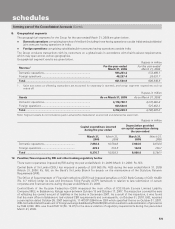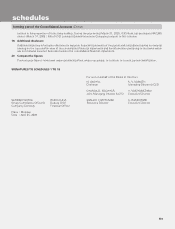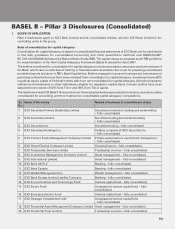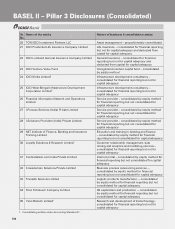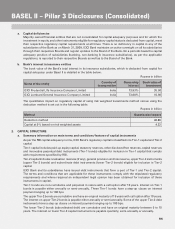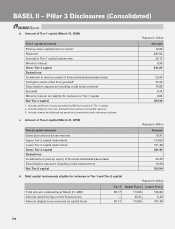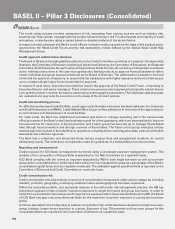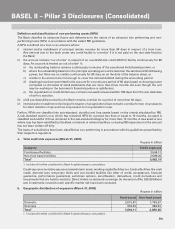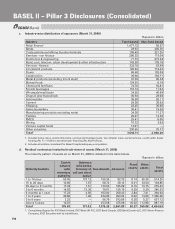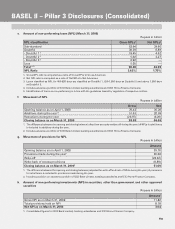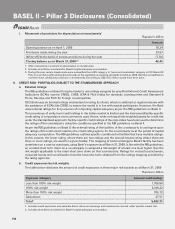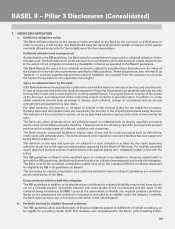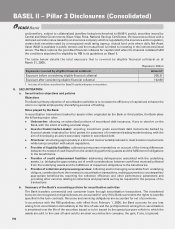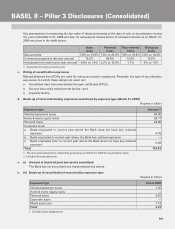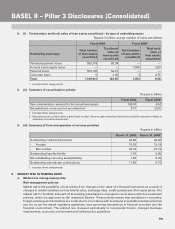ICICI Bank 2009 Annual Report Download - page 163
Download and view the complete annual report
Please find page 163 of the 2009 ICICI Bank annual report below. You can navigate through the pages in the report by either clicking on the pages listed below, or by using the keyword search tool below to find specific information within the annual report.
F89
a. Key risk indicators
Key risk indicators have been developed pertaining to various risks such as credit risk, interest rate risk,
liquidity risk and foreign exchange risk, besides internal audit ratings. These indicators are presented at the
end of every quarter.
b. ICAAP/stress testing
As part of ICAAP, the Bank has conducted stress tests under various historical and hypothetical scenarios
and assessed the impact on its capital adequacy. The outcome of such exercise has been reported to RBI as
at March 31, 2008.
Stress test is being conducted as per the ICAAP methodology approved by the Board on periodical basis for
all the risks and reported to respective committees.
c. Stress tolerance limits
In line with stress testing results, risk tolerance limits have been formulated for various risks. The actual position
against the limits is being periodically reported to respective committees.
d. Analysis of irregularities
Status of arrears/irregularities is being monitored by independent control group and is reported quarterly to
Credit Committee.
e. Reporting against prudential exposure norms
Status of actual position against prudential exposure limits set by the Board/stipulated by RBI are reported
periodically to respective committees
Measurement of risks for capital adequacy purposes
Under Pillar 1 of the RBI guidelines on Basel II, the Bank currently follows the standardised approach for credit
and market risk and basic indicator approach (BIA) for operational risk. The Bank is in the process of setting up a
framework for the adoption of the advanced approaches under Basel II and aims to migrate to these approaches
in line with the required approval and time schedule stipulated by RBI.
5. CREDIT RISK
The Bank is exposed to credit risk in its lending operations. Credit risk is the risk of loss that may occur from the
failure of any counterparty to abide by the terms and conditions of any financial contract with the Bank, principally
the failure to make required payments as per the terms and conditions of the contracts.
Policies and processes
All credit risk related aspects are governed by credit and recovery policy (Credit Policy), approved by the Board
of Directors. Credit Policy outlines the type of products that can be offered, customer categories, target customer
profile, credit approval process and prudential exposure limits.
Structure and organisation of the credit risk management group
The Global Credit Risk Management Group (GCRMG) is responsible for rating of the credit portfolio, tracking
changes in various industries and periodic reporting of portfolio-level changes. The GCRMG is segregated into
sub-groups for Corporate, Small Enterprises and Rural Micro-banking and Agri-business Group (RMAG) and Retail
businesses.
The overseas banking subsidiaries of the Bank have also established similar structures to ensure adequate risk
management, factoring in the risks particular to the respective businesses and the regulatory and statutory
guidelines. The risk heads of all overseas banking subsidiaries have a reporting relationship to the Head - Global
Risk Management Group (GRMG), in addition to reporting to the Chief Executive Officer of the respective
subsidiaries.
Credit risk assessment process
There is a structured and standardised credit approval process including a comprehensive credit risk assessment
process, which encompasses analysis of relevant quantitative and qualitative information to ascertain credit rating
of the borrower.
BASEL II – Pillar 3 Disclosures (Consolidated)


